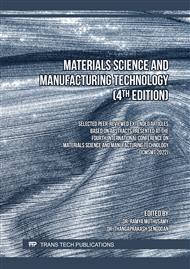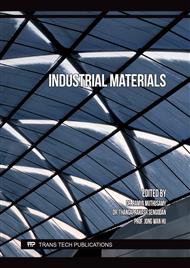p.17
p.23
p.33
p.39
p.47
p.53
p.61
p.67
p.79
Effective Complex Permittivity of Random Composite Media: PVDF/(Na1/2Bi1/2)TiO3
Abstract:
The present study discusses the fabrication of non-lead ceramic/polymer composites employing (Na1/2Bi1/2)TiO3 (NBT) ceramic powder as a filler and poly(vinylidene fluoride); PVDF as a polymer matrix. The NBT (volume fraction, ϕ = 1) ceramics were synthesized using the conventional mixed-oxide method followed by the high-energy ball milling method whereas (1-ϕ)PVDF/ϕ(Na1/2Bi1/2)TiO3; 0 ≤ ϕ ≤ 0.3 composites were prepared from a melt-mixing process. It was observed that the real and imaginary parts of dielectric permittivity, ac conductivity, and longitudinal piezoelectric charge coefficient increase with the increase in NBT-content. Different dielectric mixing models were presented to determine the effective complex permittivity of the composites. Five dielectric mixture equations have been chosen to test the acceptability of experimental data. It was revealed that theoretical models as given by Bruggman, Rother-Lichtenecker, and modified Rother-Lichtenecker show good agreement with the experimental results of filler-concentration dependent alteration of effective relative permittivity and loss factor of the PVDF/NBT composite. A mathematical model of first-order exponential growth has also been proposed, which fitted excellently the experimental data (r2 > 0.998).
Info:
Periodical:
Pages:
47-52
Citation:
Online since:
November 2022
Authors:
Keywords:
Price:
Сopyright:
© 2022 Trans Tech Publications Ltd. All Rights Reserved
Share:
Citation:



